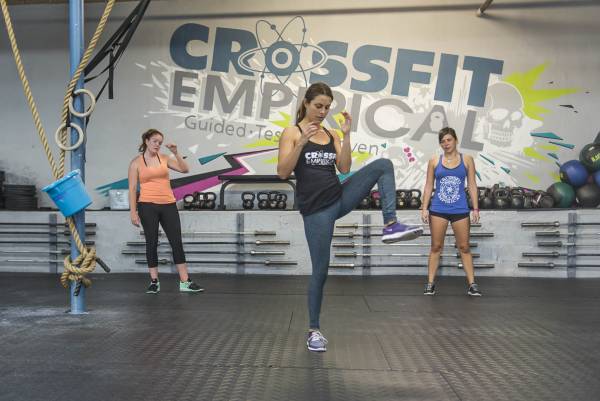Muscular force output has a huge impact on the exhibition of your sport skills, running speed, and strength displays.
When it comes to vertical muscle force output, common tests include the vertical jump and 1RM barbell squat or deadlift. The greater your vertical force output, the greater your vertical jump height potential. The greater the amount you can barbell squat or deadlift absolutely lends itself to your ability to exert more vertical force, whether it’s jumping without resistance or the aforementioned strength exercises.
I know what you’re thinking. “Duh.”
Pushing against the ground or floor in vertical force displays is a pretty simple endeavor. The greater the downward force, the greater potential upward force, all other factors being equal. But look at most sports and athletic skills. They rely on horizontal actions to excel. We are talking about moving forward and backward, side to side, and from point A to point B.
This creates a dilemma. How can you improve the horizontal force outputs necessary for optimal performance when the surface you are pushing against lies parallel to the intended movement direction?
Muscle Output and Athletic Performance
Let’s look at a 2015 study published in The Journal of Strength and Conditioning Research that examined the relationship between vertical and horizontal muscle outputs on athletic performance.
“The exact practice of these horizontal forces is needed for optimal performance. That is, sport-specific agility drills and sprint-speed practice.“
In this study, the relationship between vertical and horizontal forces in double-leg and single-leg countermovement jumps, drop jumps, and squat jumps, as well as sprinting speed, and the muscle structure of the vastus lateralis (quadricep) and gastrocnemius (calf) were investigated.
The goal was to find the relationship between both double- and single-leg countermovement jumps, drop jumps, and squat jumps in horizontal and vertical planes and:
- Sprinting speed covering 5, 10, 20, and 30 meters
- Lower-leg muscle stiffness
- Quadricep and calf muscle fascicle angle and length
The subjects used in the study were experienced male rugby players with an average age of twenty years, bodyweight of 225lbs (102kg), and barbell squat 1RM of 401lbs (183kg).
Research Results
Here is what the researchers found:
- Horizontal maximum and average forces better correlated to sprinting speed as compared to maximum and average vertical forces.
- In countermovement jump, drop jump, and squat jump tests, single-leg measures of velocity had a greater correlation to sprinting speed as compared to double-leg measures. The squat jump showed a very large correlation.
I don’t want to confuse you, but vertical measures of velocity also correlated largely to sprinting speed. Showing a large correlation to sprinting speed were:
- Drop jump single-leg maximum and average force
- Drop jump double-leg average force
- Squat jump double-leg average force in both the vertical and horizontal planes
“[R]esearch suggests using a variety of training modes where the trainee pushes against the ground in both vertical and horizontal actions.“
Other findings:
- Regarding muscle stiffness measures of the quadriceps and calves, only a minimal correlation was discovered in terms of kinetic and kinematic variables when compared to either the vertical or horizontal jumps.
- In the countermovement jump, horizontal maximum and average forces correlated better to sprinting speed when compared to vertical forces.
- Average and maximum velocity in both double- and single-leg squat jump correlated strongly to sprinting speed. This also suggests that drop jump exercises have a greater correlation to sprinting speed over longer distances. This includes both vertical and horizontal drop jump events.
What We Can Learn From This Study
Most conventional force-enhancing training centers on vertical force development, such as squatting and deadlifting. Those are fine ways to maximize muscle force output, generally. But because most sports and athletic endeavors require an optimal horizontal movement – such as forward-backward, lateral, and straight-line speed – research suggests using a variety of training modes where the trainee pushes against the ground in both vertical and horizontal actions.

In other words, keep getting stronger and practicing your required sport drills. But specifically, to enhance force in the horizontal plane to improve sprinting speed, do single-leg squat jumps emphasizing maximum horizontal velocity, i.e. jump forward. Do dynamic horizontal training movements that correlate highly to sprint performance, such as double- or single-leg bounding and double- or single-leg broad jumps.
The exact practice of these horizontal forces is needed for optimal performance. That is, sport-specific agility drills and sprint-speed practice. Practice what you need to be good at what you need.
All of us face the same dilemma. How to maximize sport-related horizontal force when we have a surface (ground/floor) that exists (parallel) to the optimal position for applying it. So, if you haven’t already been doing it, the research says to get stronger with conventional strength exercise and incorporate drills that emphasize the improvement of horizontal force output.
Check out these related articles:
- Train the Lateral Plane for Maximum Athleticism
- Lower Extremity Pain? Check Your Lateral Subsystem
- Single Leg Training: 5 Exercises and a Workout Plan
- What’s New On Breaking Muscle Today?
References:
1. Dobbs, Caleb W., Nicholas Gill, Daniel J. Smart, Daniel J., and Michael McGuigan, “Relationship Between Vertical and Horizontal Jump Variables and Muscular Performance in Athletes,” Journal of Strength & Conditioning Research 29 (2015): 661-671.
Photos courtesy of CrossFit Empirical.






